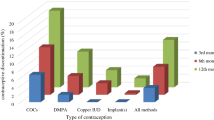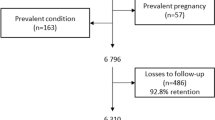Abstract
In 1983, we reported results from the Oxford Family Planning Association contraceptive study regarding the association between oral contraceptives (OCs) and cervical neoplasia, after a 10 year follow-up of a cohort of 17,000 women. Further findings from this study are reported here after an additional 12 years of follow-up. A nested case--control design was used in which cases were all women diagnosed under 45 years of age with invasive carcinoma (n = 33), carcinoma in situ (n = 121) or dysplasia (n = 159). Controls were randomly selected from among cohort members and matched to cases on exact year of birth and clinic attended at recruitment to study. Conditional logistic regression analysis was used to determine odds ratios (ORs) and 95% confidence intervals (CIs) associated with various aspects of OC use relative to never users adjusted for social class, smoking, age at first birth and ever use of diaphragm or condom. Ever users of OCs had a slightly elevated OR for all types of cervical neoplasia combined (OR = 1.40, 95% CI 1.00-1.96). Odds ratios were highest for invasive carcinoma (OR = 4.44, 95% CI 1.04-31.6), intermediate for carcinoma in situ (OR = 1.73, 95% CI 1.00-3.00) and lowest for dysplasia (OR = 1.07, 95% CI 0.69-1.66). The elevated risk associated with OC use appeared to be largely confined to current or recent (last use in the past 2 years) long-term users of OCs. Among current or recent users, ORs for all types of cervical neoplasia combined were 3.34 (95% CI 1.96-5.67) for 49-72 months of use, 1.69 (95% CI 0.97-2.95) for 73-96 months and 2.04 (95% CI 1.34-3.11) for 97 or more months. These results suggest a possible effect of OC use on later stages of cervical carcinogenesis, although residual confounding due to sexual factors or human papillomavirus (HPV) infection cannot be ruled out.
This is a preview of subscription content, access via your institution
Access options
Subscribe to this journal
Receive 24 print issues and online access
$259.00 per year
only $10.79 per issue
Buy this article
- Purchase on Springer Link
- Instant access to full article PDF
Prices may be subject to local taxes which are calculated during checkout
Similar content being viewed by others
Author information
Authors and Affiliations
Rights and permissions
About this article
Cite this article
Zondervan, K., Carpenter, L., Painter, R. et al. Oral contraceptives and cervical cancer - further findings from the Oxford Family Planning Association contraceptive study. Br J Cancer 73, 1291–1297 (1996). https://doi.org/10.1038/bjc.1996.247
Issue Date:
DOI: https://doi.org/10.1038/bjc.1996.247
This article is cited by
-
Assessing the Effectiveness of a Community-Based Sensitization Strategy in Creating Awareness About HPV, Cervical Cancer and HPV Vaccine Among Parents in North West Cameroon
Journal of Community Health (2012)
-
Cervical dysplasia and cancer and the use of hormonal contraceptives in Jamaican women
BMC Women's Health (2008)
-
Oral contraceptive use and cancer. Findings in a large cohort study, 1968–2004
British Journal of Cancer (2006)



